Educational technology (Edtech) is no longer an option but has become a necessity in the education sector of many countries in 2024.
As Covid-19 outbreak forced traditional classrooms to shift online, many breakthrough innovations in education such as online classes, learning management systems, etc., were recognized. It has become an integral part of the education system in many countries.
A report from the KPMG, Google network estimates that the Edtech sector is expected to serve 9.6 million users, with a value of $1.96 billion in 2021. Educators assert that Edtech will continue to influence the changes in education, with online learning emerging as the new normal post-Covid-19.
Below are the top 7 trends in Edtech for 2024
Virtual reality and augmented reality
Artificial Intelligence (AI) has transformed the education industry by empowering online classrooms, facilitating assessment, and enabling tracking of online learning activities. Virtual reality (VR) and augmented reality (AR) have not only helped teachers capture students’ attention but also crafted more engaging and simplified lesson plans. This enhances the interaction in the teaching and learning process, benefiting both teachers and students.
Virtual classroom
Due to Covid-19, many countries have had to impose lockdowns or close schools. Consequently, online courses have become increasingly popular. Online learning allows students to ask questions from anywhere in the world and choose classes according to their preferences. This not only creates a home learning environment for students but also enables teachers to monitor and manage their students’ learning at home.
Teachers can manage students with the help of artificial intelligence, thereby making virtual classrooms transparent and clear.
Personalize learning
Personalized learning programs are the key to education in the 21st century. Online platforms provide a flexible learning environment, enabling students to advance at their individual pace.
Learning will follow the trend of instructors providing learning materials suitable for the level and knowledge base of each student. Teachers can identify the weaknesses of each student and help them overcome them. This ensures that students develop at their own pace and achieve the best results.

Robotics
Robotics are becoming widely accepted in general education. Students can learn STEM (Science, Technology, Engineering and Mathematics) concepts through robot development and programming. In addition, building robots also helps develop skills needed in the 21st century such as: critical thinking, decision-making ability and creativity.
Cloud-based Edtech platform
The rapid advancements in technology allow for the integration of cloud technology into education. Learning programs, school records, and profiles can all be managed through cloud technology. It also helps teachers carry out administrative tasks such as fee management, online admissions, and grade sheet creation.
Blending Learning
Blending learning methods is one of the best options to ensure uninterrupted learning while also ensuring safety for students. Blended learning involves the application of both traditional and online learning methods. This model allows students to have additional time for self-study and exploration of knowledge. Additionally, combining online and in-person learning tools can promote collaboration among students to create more dynamic classrooms.
Block-based coding system
Block-based coding system is a stepping stone for high school students to approach the field of programming. Presented in block form, students can easily create multimedia projects such as animation, science projects. This programming system can enhance students’ creativity.
